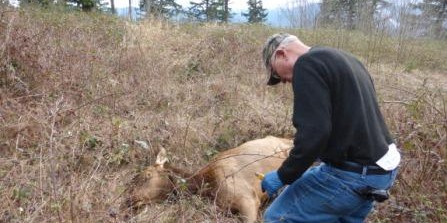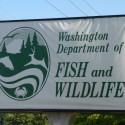“Knowledge will forever govern ignorance, and a people who mean to be their own governors must arm themselves with the power knowledge gives. A popular government, without popular information or the means of acquiring it, is but a prologue to a farce or a tragedy or perhaps both.”
–James Madison
For months, WDFW officials have been claiming the mysterious elk hoof disease ravaging the herds of southwest Washington is likely caused by treponema bacteria. At a public meeting in Longview on March 27, WDFW Director Phil Anderson told the nearly 300 citizens in attendance that regarding treponema, “We’ve got some pretty strong evidence and we’ll figure out whether we’re 99% sure or 90% sure here pretty soon.”
Now that percentage of certainty hovers somewhere between slim and none.
On June 3rd, numerous members of WDFW’s highly vaunted technical advisory group expressed serious doubts that treponema could be the root cause of elk hoof disease. Though the bacteria do appear to be involved, the unmistakable consensus was that treponemes are secondary or tertiary to other, more systemic factors.
“[Treponemes] are possibly playing a role, but they’re not the entirety,” said Jennifer Wilson, a research microbiologist with the USDA.
“I buy the fact that it’s acting like a novel introduced disease. I’m just saying this treponema data does not support that,” said Tom Besser, a specialist in Veterinary Microbiology and Pathology at WSU.
“I also have a little bit of a concern because the treponema hypothesis still requires an initiating event… Until you figure out what that triggering event was you’re not going to be able to really understand the disease,” said Dr. Anne Fairbrother, an Ecotoxicologist with Exponent Engineering and Scientific Consulting.
“You’re mentioning lots of different bacteria. That’s one piece of the puzzle… but there are other things that seem to be missing in the puzzle. Big pieces. The big pieces are the environmental factors and why this particular region and not other regions,” said Dale Moore, an expert in preventive veterinary medicine at WSU.
Now, more than 20 years since the onset of elk hoof disease, and nearly 5 years since they began “actively” investigating this condition, WDFW is left without a single viable working hypothesis. Despite all of this, WDFW officials still insist they are giving it their best effort.
Asked to weigh in on the matter, wildlife activist Bruce Barnes said, “They’re playing the public for a bunch of fools.”
Nearly all diseases are the result of a complex plethora of factors, and elk hoof disease is certainly no different. As Dr. Wilson explained during the meeting on June 3rd, “Lameness is not a simple answer. It’s not a one-factor thing. There’s many different things that come into play including stress, the nutritional status of the animal… and also looking at diet.”
Dr. Wilson described why she believes treponemes are more likely secondary invaders rather than primary pathogens. “Treponemes aren’t a real suspect for initial colonizers,” she said. “There’s a consortium of bacteria there that initially colonizes that skin, and that skin may be damaged due to moisture, abrasion or just a weakened immune state of the animal.”
This notion that the elk are more susceptible to pathogenic bacteria because of weakened immune systems is not only accepted by expert scientists, but it is one of the central arguments voiced by those who believe herbicides are at the root of the problem. Some of the most common herbicides like atrazine are known to be immunotoxic, and that particular chemical can disrupt the function of the immune system by as much as 70%.
According to Fairbrother, the lone toxicology expert present during the meeting, herbicides have “no known mode of action in mammals” and they are “practically nontoxic.” When considering these assurances about the safety of herbicides, the public should consider that Fairbrother’s company, Exponent, is known for “its scientific research on behalf of corporate clients facing product liability concerns.” In 2011, Exponent became embroiled in controversy when they were exposed for “donating” money to the CDC Foundation in exchange for research that would refute studies showing that even a small amount of exposure to two pesticides, maneb and paraquat, can raise the risk of Parkinson’s disease. The public should also be aware that Exponent has regularly worked for Syngenta, the manufacturer of atrazine, one of the most commonly sprayed herbicides in southwest Washington. All of this, of course, throws into question the objectivity of statements about the “practically nontoxic” nature of herbicides.
Importantly, Fairbrother stated during the meeting that “immunotoxicity is not a required test during pesticide registration.” Without full immunotoxicity information for all the herbicides being sprayed on local elk habitat, it is currently impossible to know the true impact these chemicals are having on an animal’s immune system, and therefore how much more susceptible they are making our wildlife to a whole gamut of diseases.
Next, consider that a recent study published in April 2014, in the journal Biomedical Research International, revealed that a common herbicide known as Roundup is vastly more toxic than present regulatory studies would suggest. According to the researchers, Roundup was “found to be 125 times more toxic than its active ingredient glyphosate studied in isolation” while some of the supposedly ‘inert’ ingredients known as adjuvants were found to be more than 10,000 times more toxic than glyphosate itself.
This new understanding of true herbicide toxicity is of particular importance to this elk hoof disease case because as Fairbrother pointed out during the meeting, glyphosate is the most widely used herbicide in our forests. According to a recent elk nutrition study conducted locally by researchers from the University of Alberta, “A typical site preparation might include an aerially applied treatment of 1.5 quarts glyphosate and 3 ounces of sulfometuron methyl in 10 gallons of solution per acre.”
As Dr. Wilson pointed out early in the meeting, diet and nutrition are among the most important factors underlying the difference between hoof health and hoof disease in ungulates. Abundant forage, a critical factor in the well-being of a wild ruminant, seemed to be an afterthought in Fairbrother’s presentation.
“I have actually never seen an area where the use of forest herbicides can be directly related to any adverse effect,” she said. “I mean, other than the fact that some particular forage no longer exists.”
WDFW’s technical advisory group demonstrated that it’s not just citizen activists who believe ‘hoof rot’ may be associated with our forest practices. Dr. Paul Kohrs, Acting State Veterinarian with the Department of Agriculture, stated that “something must be done different down here with forest practices” and added that “it needs to be explored.”
Dr. Gary Haldorson, a clinical instructor and veterinary pathologist at WSU, wondered whether WDFW will be able to understand the detrimental effects of herbicides and their role in hoof disease until testing is done on live elk.
“Are there also studies where you just give these chemicals at low doses to animals and see what happens?” Haldorson asked. “I mean, long-term. Here is the theory that I’m throwing out there as a random theory, but what if one of these chemicals could cause defects in the keratinization over time? Well, if we’re not looking for defects in keratinization as an end point, then would any of the studies ever know that?”
“Yeah, you wouldn’t,” answered Fairbrother.

It shouldn’t be forgotten that after more than a year of persistence, Dr. Boone Mora, a Parasitology expert and former County Health Director, was finally allowed to make a full presentation about his theory that a bacterial infection known as leptospirosis is somehow involved with this epidemic of hoof disease, and that it poses a serious health concern for hunters when harvesting an elk in southwest Washington.
“Leptospirosis kills persons and animals,” Dr. Mora explained. “Just recently, out in Naselle at the County Pet Vet, and in Longview, leptospirosis was killing dogs.”
Leptospirosis is considered the world’s most common zoonosis, meaning it is a communicable disease passed between animals and man. Leptospirosis is also an elusive and routinely misdiagnosed disease that can’t be seen under a regular microscope and is often mistaken for other diseases like aseptic meningitis, hepatitis, influenza, pneumonia, brucellosis and food poisoning. As Dr. Mora wrote in his 1978 dissertation devoted entirely to leptospirosis, “Of 318 cases in which initial impressions were recorded, only 17 percent were suspected of having leptospirosis.”
According to Dr. Mora, “Leptospirosis is everywhere in southwest Washington,” and WDFW’s own research indicates the bacteria have been widespread in the elk population since the early 90s. Dr. Mora also explained that because symptoms of leptospirosis are so broad, “it is common for epidemics to go undiagnosed.” In the 1940s, outbreaks of a fever at Fort Bragg, North Carolina, remained undiagnosed as leptospirosis for eight years. In the Andaman Islands, it took fifteen years for Andaman hemorrhagic fever to be identified as leptospirosis, and it is likely the cause of a mysterious kidney disorder that is presently killing thousands of agricultural workers each year in Central America.
One of the most common symptoms of leptospirosis is severe pain in the lower limbs and central to Dr. Mora’s theory.
“It’s the pain that causes the elk to limp, and when he limps he doesn’t use that hoof very much, and when he doesn’t use that hoof very much it doesn’t wear, and if it doesn’t wear it overgrows, and when it overgrows it misaligns. There comes a time when that misalignment is irreversible.”
Whether leptospirosis is causing hoof overgrowth, or is more simply a byproduct of weakened immune systems, WDFW’s own data show that these contagious bacteria are irrefutably present in the elk herds. Considering the health risks associated with this deadly disease, hunters, wildlife activists and now other government officials believe leptospirosis needs to be thoroughly and promptly investigated by WDFW.
Just yesterday, June 10th, all three Wahkiakum County Commissioners signed a letter of grievance addressed to WDFW stating that, “Wahkiakum County and its citizens are deeply troubled by the actions of the Washington Department of Fish and Wildlife regarding the hoof rot disease.” In this letter they collectively ask, “Why won’t WDFW let Dr. Boone Mora study this disease which he has stated he will do on his own time and with little help from fish and game?” In closing, the commissioners write that, “Dr. Mora has other citizens who wish to help and the project would be called ‘Citizens for Healthy Elk.’”
For those critics out there who continue to dismiss leptospirosis as a fringe issue, consider what Dr. Wilson (the USDA research microbiologist) had to say to WDFW officials on June 3rd. “Leptospirosis is one of those that as soon as you try to put it in little boxes and say this strain does this in this species, you’ll get yourself proven wrong.”
Dr. Mora, a tireless servant of the public, deserves the last word:
“There is nothing wrong with politics, unless you try to substitute it for science.”
My ongoing investigation of elk hoof disease and toxic forest practices is funded entirely by my readers. If you appreciate my work and believe that journalism should be fearlessly independent of corporate influence, then consider clicking on the donate button below so that I can continue giving these issues the time and attention they deserve. Thank you for your support.


I blog often and I truly appreciate your content.
This article has really peaked my interest. I will take a note of
your site and keep checking for new information about oonce per week.
I opted in for your RSS feed too.
Pingback: Growing Evidence Links Herbicides to Elk Hoof Disease